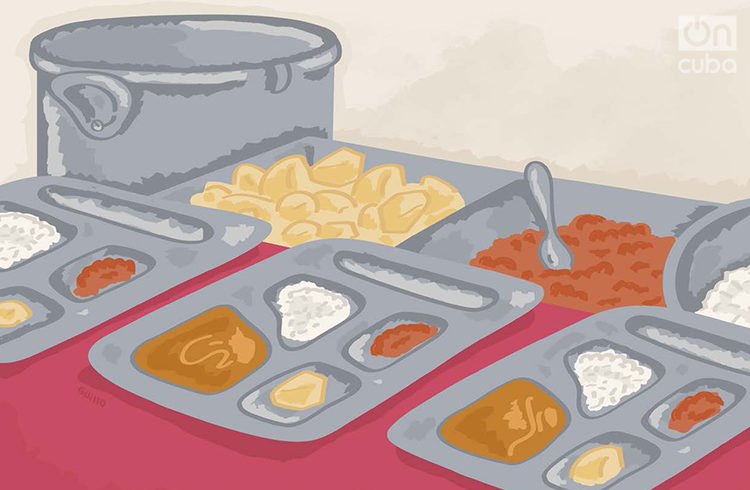During diverse historic periods, contingency food has been a constant in Cuba: providing food for the slaves, the Mambí independence fighters, the farmers, workers, rebel troops, marginal barrios; the search for a solution in extreme circumstances, difficult or restricted like the periods of drought, tropical storms, intense rainfalls, acute economic crises.
The generations born in the 1960s and ’70s, throughout the country have a marked influence of the food regimens introduced by the government’s policies at the different levels of the educational system. We perpetuate habits and tastes derived from our experiences in the so-called canteens, in the first levels of education as well as in the following: junior and senior highs (schools in the countryside), as well as in the family options in public and other places.
We are not generations with a deep knowledge of general culinary and eating cultures. In our first years of life we were fed, in the sense of nutrition, but with great limitations in the variety of foods and their form of cooking and eating them.
The dynamics of the canteens made many of us get used to eating our food with one spoon (big, from soup to dessert), and have inconceivable mixtures be decided, while everything was served at once on a tray, and each one of us chose how and when to eat them.
The fact of living with colleagues and friends favored a special sense of solidarity and lack of prejudice to share and exchange what was served in the canteens as well as outside of them, including the foods stored and brought from home, many of them real “jewels of culinary imagination,” known as tentempiés (snacks), based on the need to conserve food for several days to supplement the insufficient and not very liked school diet.
Our memories come alive with the recollections of eating, at dawn or during the evenings, the “fanguito” (canned condensed milk cooked in bain-marie), toasted cornmeal with sugar, peanut candy, cooked cream paddies, cookies and crackers, torticas de morón, candies made from molasses, candy made from sugarcane juice, homemade mayonnaise or spreads for dressing prepared with what was at hand, powdered milk (cans imported from the then Soviet Union) and powdered chocolate, mixed with sugar without being diluted, guava paste and homemade cheeses (the “timba” is prepared with the bread, the guava and cheese), hard candies, etc.
Those canteens, which were not conceived to follow the most elemental rules of gastronomic services, had a characteristic smell, not agreeable at all, that rather recalls the smells of what we Cubans contemptuously call “slop.” Among the routine offers there was cow milk – with no additives, that is to say, without coffee or chocolate, with large amounts of skin on top – or natural half warm yogurt. The most frequent soups most frequently served were black-eyed and kidney beans, there was the pea soup and, with very great frequency, imported canned fish like sardines, shark, mackerels, and macarela or others.
Eggs were a constant in the offers, almost always scrambled and uncolored or boiled and served whole, au naturel. On occasions we ate small portions of chicken or beef or pork, previously boiled, with some tomato or some sort of seasoning and minimal amounts, also the pig’s pata y panza, a menu that was rejected very frequently, cornmeal, boiled, with no seasoning, the combination of soup and “surprise” yellow rice (meaning that someone would be lucky if a piece of meat appeared inside it). In terms of season vegetables, occasional, the predominant memory of tomatoes and cucumbers, withered and au naturel, remains with us.
One of the spaces designed on the tray was set aside for the only piece of sweet potato, plantain (green or ripe), squash or potato, always boiled and also au naturel. About the desserts we still remember the custard, rice pudding or oatmeal (a cooked cereal with a sticky texture like plasticine), served at room temperature because there was no time for it to cool. Very sweet guava or mango marmalades were also frequently served.
Then, what happened once a week? The families would come in swarms and, all of a sudden, we would eat too many tidbits like croquets – a food that deserves a study in Cuban cooking – bread with…, soft drinks, all types of sweets, and much more. For the weekend, at home what was considered exclusive and exquisite was collected: the beef steak or the chicken breast, the French fries or the fried cassava, the rice cooked with black or kidney beans, the flans and puddings, among other foods put away zealously because getting hold of them was difficult or very limited.
Paradoxically, the benefits of the agricultural and rural surroundings of the schools in the countryside were not taken advantage of to pass on an integral culture directed at a good diet, health, ecology and eating traditions. We went through those schools and above all we always felt the being closed up, the need to subsist on contingency diets and cooking, that defined, to a certain extent, the limited eating habits and the disinterest about a balanced diet.
To end these incomplete and simple notes of my reminiscences, which undoubtedly form part of our collective memory, I don’t want to leave out something that also marked and defined tastes and pleasures for our not too demanding palates during childhood and adolescence: the “afternoon snacks from primary education” (from first to sixth grade), fundamentally comprising the tortica de morón or the masarreal and the soft drinks, of the Son make, in glass bottles, in individual doses, of coke, orange, pineapple or malt drink, directly drinking them from the bottle, always at room temperature.
All that, and more, also forms part of the why and how we Cubans understand the preferences and habits related to food.










